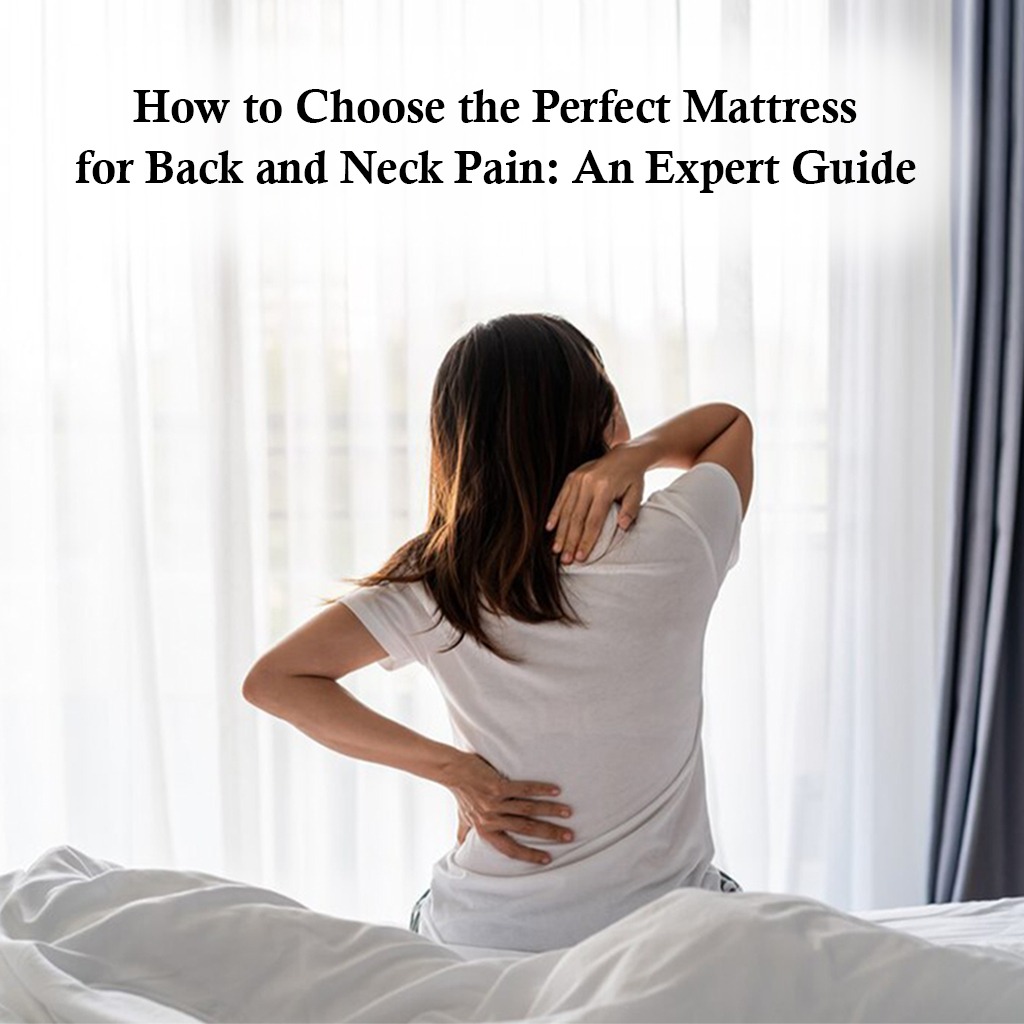How to Choose the Perfect Mattress for Back and Neck Pain: An Expert Guide
Choosing the right mattress can make a world of difference in managing back and neck pain. With so many options on the market, it can be overwhelming to know where to start. This expert guide will walk you through the key factors to consider, provide expert tips, and offer practical advice to help you make an informed decision.
Understanding Back and Neck Pain
Before diving into mattress selection, it’s important to understand the common causes of back and neck pain. These can range from poor posture during the day to inadequate support while sleeping at night. Many people are unaware that an old or worn-out mattress can significantly contribute to their discomfort. Additionally, underlying medical conditions such as arthritis, scoliosis, or herniated discs can exacerbate pain, making the need for a supportive mattress even more critical.
Key Factors to Consider
When shopping for a mattress, several key factors should be taken into account to ensure you choose the best option for your specific needs.
Mattress Type
Different types of mattresses offer varying levels of support and comfort. Understanding these differences can help you make a more informed choice.
Memory Foam: Memory foam mattresses mold to the contour of the body, with great pressure relief. This could be most useful in cases of back and neck pain as the weight of the body is evenly distributed, reducing chances for pressure points. However, memory foam can retain heat, making this uncomfortable for some sleepers.
Innerspring: Traditional innerspring mattresses have steel coils for support. They are known for durability and good airflow. Innerspring mattresses come in different comfort levels, making them the best for any style of sleeping. On the downside, they might give in more quickly and offer less contouring support compared to other types.
Hybrid: Hybrid mattresses blend memory foam and innerspring coils for balanced support and comfort. These tend to give the pressure relief of memory foam but with the support and bounce of innerspring coils. Although they can be more expensive than many, a lot of people requiring complete support find them good value for money.
Latex: Built from either synthetic or natural latex, these mattresses are durable and comfortable for sleepers. That is because the latex offers good support but is generally cooler than memory foam to sleep on. They can be quite heavy and often come with an equally high price tag.
Airbed: It is also possible to adjust the firmness level with an airbed by inflating or deflating the mattress. The high level of customization may actually be good for some people with very specific support requirements. However, they can be noisy and run the risk of leaks.
Mattress Type | Description
| Pros
| Cons
|
Memory Foam | Molds to the shape of your body | Excellent pressure relief, reduces motion transfer | Can retain heat, can feel too soft |
Innerspring | Traditional mattresses with steel coils | Good support, variety of firmness options | May wear out faster, less contouring |
Hybrid | Combination of memory foam and innerspring coils | Balanced support and comfort | Can be expensive |
Latex | Made from natural or synthetic latex | Durable, good support, and comfort | Can be heavy, expensive |
Airbed | Inflatable mattress with adjustable firmness | Customizable firmness | Can be noisy, risk of leaks |
Firmness Level
Choosing the right firmness is crucial for supporting your spine’s natural alignment. The firmness level of a mattress directly affects its ability to support your back and neck properly.
- Soft: Soft mattresses are best for side sleepers as they contour the body, providing cushioning to the shoulders and hips. However, they may not offer enough support for back or stomach sleepers and can lead to improper spinal alignment.
- Medium Medium-firm mattresses are ideal for back sleepers, offering a balance of support and contouring. They help maintain the natural curve of the spine, reducing the risk of back pain.
- Firm: Firm mattresses are suitable for stomach sleepers or those with lower back pain needing extra support. They prevent the body from sinking too deeply, which can help keep the spine aligned.
Support and Comfort
Support and comfort are two of the most important aspects to consider when selecting a mattress.
- Support: A good mattress should provide adequate support to keep your spine in a neutral position, preventing any unnatural curvature. This is essential to avoid or alleviate back pain.
- Comfort: While support is crucial, comfort cannot be overlooked. A comfortable mattress provides a cushioning effect that reduces pressure points, allowing you to sleep peacefully through the night.
Expert Tips for Choosing the Perfect Mattress
Here are some expert tips to help you find the perfect mattress:
Test Before You Buy: Lie on each mattress for at least 10-15 minutes in your usual sleep position. That will give you a better idea of how it will feel through the night. Don’t hesitate to roll over and switch positions.
Check the Return Policy: Ensure there is a good return policy or trial period in case the mattress doesn’t work out. Most manufacturers will offer trial periods from 30 days up to 120 days, whereby one can test the mattress from the comfort of their home. It is crucial to know how the return process works and if there are any other extra fees connected with it.
Look for Zoned Support: Some mattresses are formulated to give targeted support to different body areas, which is helpful for back and neck pain. Zoned support can offer more firmness to the lower back and give softer support to the shoulders and hips to keep the spine aligned properly.
Consider Adjustable Beds: Adjustable beds can help you change the angle of the mattress, thus offering on-needed support and comfort for each individual. An adjustable bed will be most beneficial for individuals who have chronic pain conditions or any medical condition. Adjustable beds could be raised at the head and foot areas to reduce pressure and improve circulation.
Read Reviews: Customer reviews can give you an idea of how long it may last and how comfortable it may be. Make sure to read from people with similar sleep preferences and pain issues. The reviews are pointers of problems that might be experienced, hence with realistic expectations.
Practical Advice for Better Sleep
In addition to choosing the right mattress, there are several steps you can take to improve your sleep quality and reduce back and neck pain.
Maintain a Sleep Schedule: Routine in going to bed and waking up every day will help in the quality of sleep. Regular sleep time is part of setting your body’s internal clock to help one fall asleep and wake up.
Sleep Position: Make certain your pillow fully supports your neck perpendicular to your spine. Just getting the right pillow can really be helpful in alleviating your neck pain. For example, side sleepers may consider a slightly thicker pillow, and a back sleeper may go with a medium-thick pillow to always keep the neck in line.
Invest in a Good Pillow: A good pillow can considerably help alleviate neck pain. Consider getting a pillow manufactured for your type of sleeping position for increased support like memory foam or latex.
Regular Mattress Maintenance: Rotation of your mattress every 3–6 months ensures it does not sag unevenly. This may increase the life expectancy of your mattress while keeping the supportive feature of the same. Occasionally, it is an idea to try flipping your mattress over.
Exercise and Stretching: Exercise and stretches will improve the strength of your spine support muscles, reducing your chances of getting back and neck pain. Include activities in your life that promote both core strength and flexibility.
Ergonomic Sleep Environment: Do make your bed and pillows an environment also conducive for sleep—sleep accessories that are ergonomic and supporting. The height and firmness of the bed frame are good enough; most important is quality bedding.
Conclusion
Choosing the perfect mattress for back and neck pain involves considering various factors such as mattress type, firmness level, and personal comfort preferences. By following the expert tips and practical advice outlined in this guide, you can make an informed decision and enjoy a restful, pain-free night’s sleep.
Remember, in a way, a good mattress is considered an investment in your health and well-being, so take time and choose wisely—don’t rush through it. Test out various options and determine which type would work best for you. Also, feel free to take advice from healthcare professionals if need be. Happy sleeping!







